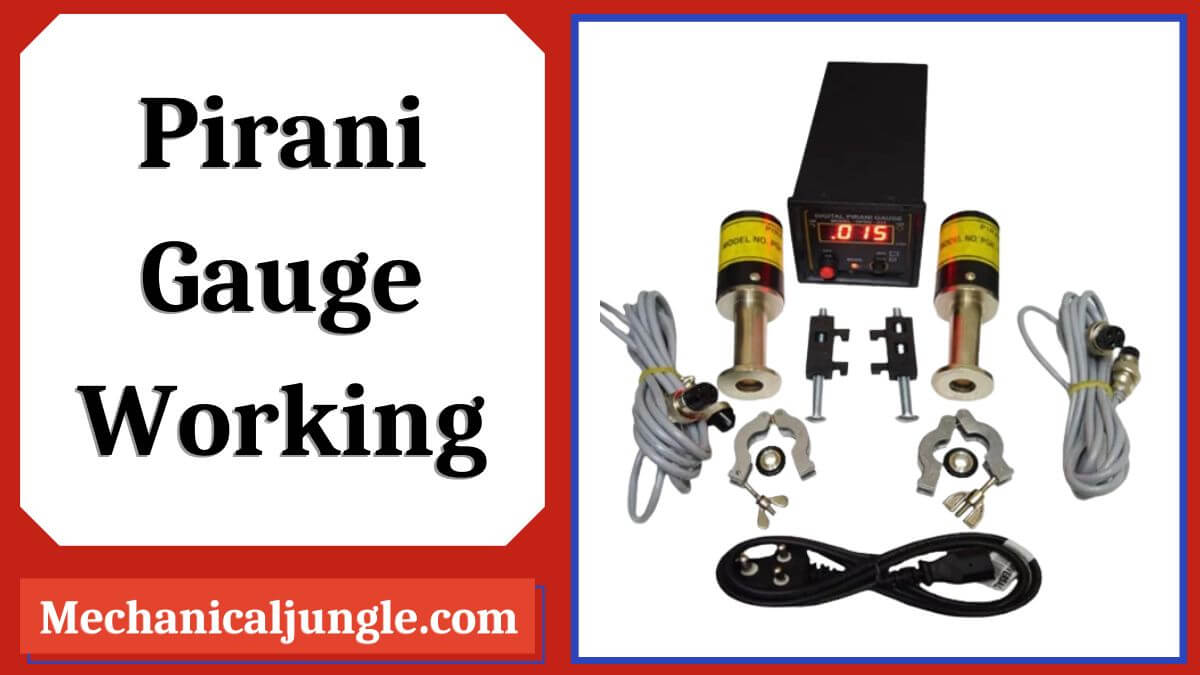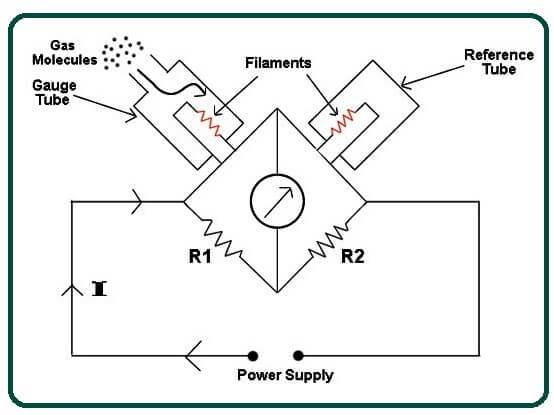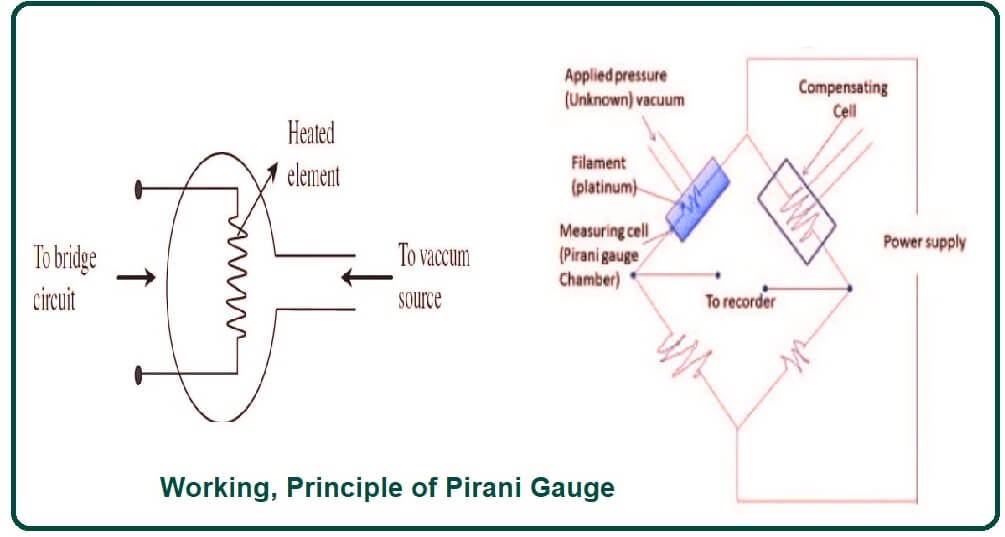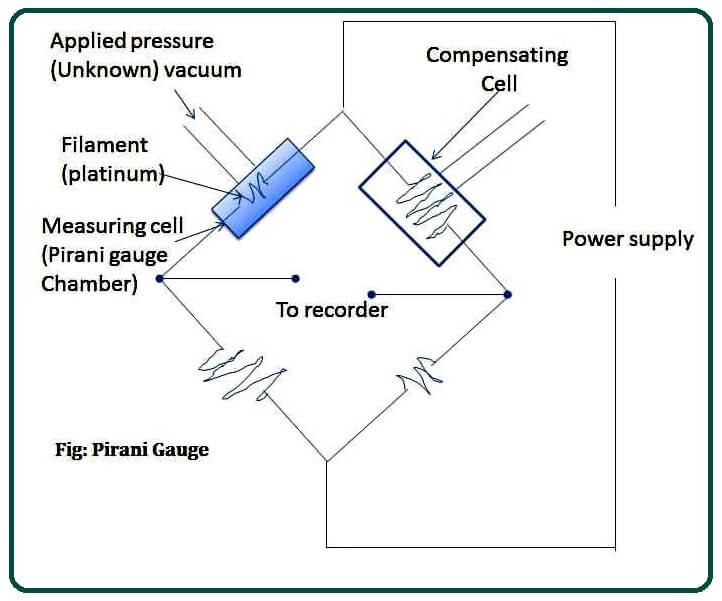Important Point
What Is Pirani Gauge?
The Pirani gauge is a device used to measure pressure, especially in vacuum systems. It was invented in the year 1906 by Marcello Stefano Pirani, a German physicist.
It is based on a hot metal wire that is suspended in a tube and exposed to gas pressure media. These hot metal wires are made of thin tungsten, nickel, or platinum wire.
It works by measuring the change in thermal conductivity and uses this measurement to obtain the pressure of the system. This gauge is suitable for measuring pressures in very low pressures in the range from 0.1 to 100 pascals.
Also, Read: Domestic Electrolux Refrigerator | Different Components of Domestic Electrolux Refrigerator
Working of Pirani Gauge:
First, the power supply is supplied to the Pirani Wheatstone bridge. The filament in the gauge tube and reference tube begins to heat up. The filament in both tubes will be heated to about 50 ° c. The gauge tubes are open to the system, & the reference tubes are closed.
This Piranis gauge is placed in the system on which to measure the pressure. As soon as the gauge tube is open, gas molecules from the system will enter the gauge tube and collide with the hot filaments. Then the gas molecules that collide with the filament will receive heat from the filament and escape from the gauge tube.
The heat exerted by the gas molecules will depend on the system pressure.
This depends on the pressure of the system because when the environmental pressure is high, the density of the gas will be higher and will carry a greater amount of heat from the filament. As it will take more heat from the filament, it will cool the filament faster.
When the system pressure is low, the gas density will also below. Due to the low density and long free path between the gas molecules, the thermal conductivity of the gas will be low and carry less heat from the filament. So, the filament will slowly cool down compared to high pressures.
So, we can say that the thermal conductivities of a gas depend on its pressure. The filament wire is maintained at a constants temperature, which is typically 50 ° c. When the gas pressure changes, its thermal conductivity changes, and therefore the voltage required to maintain the temperature of the voltage changes.
The required voltages changes because the rate of cooling of the filament changes with the change in the thermal conductivity of the gas, which changes due to the change in pressure. Now, the voltages of the Wheatstone bridge are set to hold the filament at a constant temperature, and this required voltages value is converted to a pressure value.
The electrical circuit is connected to a sensor wire from which pressure readings are taken. In this way, the pressure of the systems is measured using Pirani gauges. Pirani gauges need to be separated when the pressure of different gases is to be obtained as thermal conductivity, and the heat capacity varies from one gas to another.
Also, Read: Inversion of Double Slider Crank Mechanism
Construction of Pirani Gauge:
The Pirani gauge consists of the Wheatstone bridge, which consists of two-foot gauge tubes and a reference tube. Both tubes have fibers present inside them.
The gauge tubes are open to the system whose pressures are to be measured, and the reference tube is closed. Gauge tube filament is used to measure environmental pressure.
The reference tube is present on the opposites side of the gauge tube, which is used to obtain the temperature by which the filament temperature is heated due to the interaction of gas molecules.
The filament material in both tubes is made of tungsten, nickel, or platinum. This filament is very thin and always less than 25 µm. The power supply is used to pass the current at the Wheatstone bridge.
Also, Read: Working of Kaplan Turbine | What Is a Kaplan Turbine? | Main Parts of Kaplan Turbine
Principle of Pirani Gauge:
A conductor wire is heated when it flows through an electric current. The rate at which heat is transmitted from this wire depends on the conductivity of the surrounding media. The conductivity of the surrounding media depends on the density of the surrounding media (that is, the lower the pressure of the surrounding media, the lower its density will be). If the density of the surrounding media is low, its conductivity will also below, allowing the wire to be hot for a given current flow and vice versa.
- A Pirani gauge chamber that encloses a platinum filament.
- A compensating cell to reduce the variation caused by ambient temperature changes.
- The Pirani gauge chamber and compensation cell are mounted on a Wheatstone bridge circuit, as shown in the diagram.
Also, Read: Vane Blower Compressor | Construction of Vane Compressor | Working of Vane Compressor
Operation of Pirani Gauge:
- A continuous flow is passed through the filament in the patronage gauge chamber. Due to this current, the filament heats up and assumes a resistance that is measured using a bridge.
- Now, the measured pressure (applied pressure) is connected to the Pirani gauge chamber. The applied pressure changes the density around the Pirani gauge filament.
- Due to this change in the density around the filament, its conductivity changes, which causes the temperature of the filament to change.
- When the temperatures of the filament change, the resistance of the filaments also changes.
- Now, the change in resistance of the filaments is determined using the bridge.
- This change in resistance of the Piranis gauge filament becomes a measurement of applied pressure when calibrated.
Also, Read: Autocollimator Working | Principle of Autocollimator | Parts of Autocollimator | Types of Autocollimator
Advantages of Pirani Gauge:
- They are rugged and inexpensive.
- It gives accurate results at low pressure.
- Pressure measurement can be read remotely.
- This gauge is preferred over the thermo coupler gauge, which is another type of thermal conductivity gauge.
- It is preferred because it is ten times faster, and a wider range of pressures can be measured.
Applications of Pirani Gauge:
- Used to measure pressure at low pressures and high vacuum pressure.
- It is also used a plot graph based on the data obtained.
Special Form of Pirani Gauge:
- A special form of Pirani gauge is the pulsed Pirani vacuum gauge.
- In this particular form of Pirani gauge, the filament wire is not operated at a constant temperature; instead, it is cyclicly heated to a certain temperature range.
- The filament wires are heated using an increasing voltages ramp.
- The heating voltage stops when the threshold temperature is reached, after which the filament wire is cooled again.
- The time required to heat the filament wires at a certain threshold temperature is used as a measurement that is then converted to a pressure value.
Frequently Asked Questions (FAQ)
What Is Pirani Gauge?
The Pirani gauge is a device used to measure pressure, especially in vacuum systems. It is based on a hot metal wire that is suspended in a tube and exposed to gas pressure media. These hot metal wires are made of thin tungsten, nickel, or platinum wire.
Pirani Gauge
A Pirani gauge measures pressure by detecting the heat flux change from a heater to a heat sink, as discussed in Section 2.04. 3.4. The interface for this device is straightforward yet offers high resolution and accuracy.
Pirani Pressure Gauge
The Pirani gauge measures the vacuum pressure-dependent thermal conductivity from the heated wire to the surrounding gas. The heated Pirani sensor filament is typically made of a thin (<25 µm) Tungsten, Nickel, or Platinum wire.
Working of Pirani Gauge
The Pirani gauge measures the vacuum pressure-dependent thermal conductivity from the heated wire to the surrounding gas. The heated Pirani sensor filament is typically made of a thin (<25 µm) Tungsten, Nickel, or Platinum wire. As gas molecules collide with the filament wire, heat is transported from the hot wire.
Pirani Vacuum Gauge Working Principle
The traditional Pirani vacuum gauge, originally invented in 1906 by Marcello Stefano Pirani, is based on a hot metal wire suspended in a tube that is exposed to gas pressure media. The Pirani gauge measures the vacuum pressure-dependent thermal conductivity from the heated wire to the surrounding gas.
Advantages of Pirani Gauge
Pirani gauge is often preferred over thermocouple gauge because it is ten times faster, and a wider range of pressure can be measured. Response to pressure change is good. The pressure and resistance relation are linear for the range of use. Reading can be taken remotely.
Pirani Gauge Application
Used to measure pressure at low pressures and high vacuum pressure. It is also used a plot graph based on the data obtained.
Like this post? Share it with your friends!
Suggested Read –
- Difference Between Orthogonal and Oblique Cutting | Orthogonal Machining
- What Is Magneto Ignition System | How Does an Ignition System Work | How Does a Magneto Work | What Does a Magneto Do | Magneto Ignition System
- What Is a Synchromesh Gearbox? | Principle of Synchromesh Gearbox | Construction of Synchromesh Gearbox | Working of Synchromesh Gearbox
- Working of Constant Mesh Gearbox | What Is a Constant Mesh Gearbox? | Different Gear Ratios in Constant Mesh Gearbox | Construction of Constant Mesh Gearbox
- What Is Cupola Furnace? | Cupola Furnace Design । Cupola Construction | Purpose of Cupola | Working Principle of Cupola Furnace: | Advantages of Cupola Furnace | Disadvantages of Cupola Furnace | Applications of Cupola Furnace





Leave a Reply